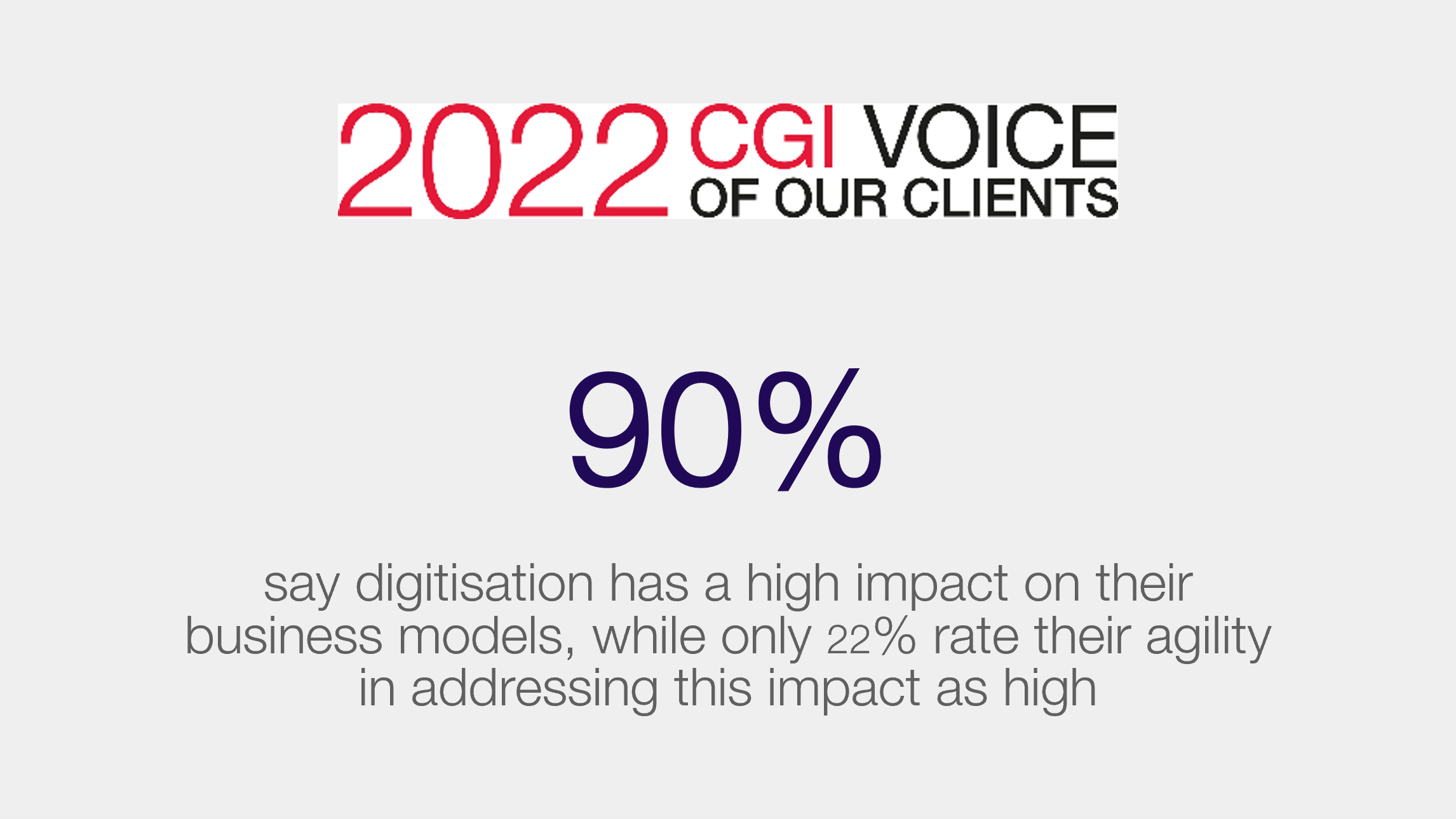In this series, I will be exploring the role managed services can play as a strategic enabler as well as some of the challenges and lessons learned from the past where outsourcing got it wrong.
Now more than ever companies must innovate and transform to remain relevant and competitive. The Pandemic showed us just what is necessary to quickly pivot to new ways of working. Arguably though this process was made easier by the existence of consumer tools for collaboration that were easily accessible (WhatsApp & Zoom) and many of us were already entertaining some level of hybrid working many years before offices closed. It was a surprisingly easy and natural transition for many. Yet when tackling the transformation of large monolithic back-end systems, things start to move considerably slower, and change becomes that much harder for organisations to tackle. In a recent survey of over 1,600 business and IT executives (CGI’s Voice of the Client survey 2022), CGI found that while over 95% of firms claim to have a digital strategy, only 25% of organisations are achieving the desired return on their digital transformation investments.

Access to high quality talent and experience is one of the primary gating factors, as is the level of technical debt and the need to continue to invest in legacy assets. Pivoting to an agile product mind-set has been hard for these organisations despite multiple attempts, behaviours tend to roll back. Organisations often turn to technology consultants to address the talent and labour shortage but frequently find themselves with massive multi supplier governance headaches with little accountability of service providers, despite the large external spend.
Relying on insourced IT is not always the right option for every organisation either. Competition for resources remains tough and the economic outlook is far less certain post pandemic with global supply chain disruptions and rising interest rates to curb record levels of inflation that has caused a global cost-of-living crisis. It is extremely likely businesses will be forced to re-examine use of capital and cash in the near term to ensure they can weather what is to come. Where it was relatively easy in the past to secure funding for ‘experiment to learn’ initiatives, we can expect CFOs to be placing far more scrutiny on technology spend that isn’t yielding the promised business benefit. This could stop many digital innovations dead in their tracks.
In difficult economic conditions, more organisations are likely to be looking at outsourcing or, as it’s more recently been called, ‘managed services’ to free up cash in order to invest into business transformation. There are however lessons from the past that need to be considered before embarking on this path. More on that later.
Taking an evolutionary approach to digital transformation
By now almost every organisation is somewhere along their digital journey having made considerable investments over the last few years, with a multi-year plan in place and strategic objectives set. Although, as we learned from CGI’s recent survey, most are not yet getting sufficient business value. What we do see is that, of the organisations who are achieving real business value from their digital transformation, many have chosen partners that can work across the business and IT domains, helping to align business and technology strategy and who have the capabilities to enable the vision. It’s not enough for a supplier to just provide staff anymore, successful partners provide real expertise, strong governance, processes and technology enablers alongside configurable pre-built solution components and transformation accelerators that can be tailored to your needs. The right partner will be willing to invest in your roadmap, backing their own capabilities. This close integration and alignment with your partner is best accomplished through a longer-term strategic partnership.
Suppliers will often try to convince clients to adopt standard product offerings or service templates that are easier and more cost-effective for them to implement and often conveniently exclude the aspects of the services needed for an end-to-end solution. But for organisations that need help to accelerate their existing plans, this can feel like fitting square pegs into round holes or necessitate starting over. Unless you can pivot your business to adopt an ‘out of the box’ set of solutions, it may help to find a partner that will ‘co-create’ to align with your own product roadmaps that can accelerate and measure the success of your digital transformation. Leveraging the best of what they have to offer with your own unique assets and capabilities.
I’ve been involved with managed services for the last 25 years having sold and delivered some of the most complex programmes and often been asked to help turn around distressed situations that haven’t worked out so well for either party. From this experience I’ve learned there are several key components of a healthy long-term relationship between any organisation and its technology partner. Getting these right will build trust and confidence allowing teams to work more closely together and blur the lines between traditional client and supplier teams.
- Closely align Business and IT on the digital roadmap enabled by the Partnership
- Measure not just what needs to get done but also the expected business outcomes
- A governance model with joint accountability that is built to learn and adapt over time
- A partnership with a supplier with both the capability to deliver and a stake in the outcome (talent, assets, and capital).
Business and IT alignment
Rather than simply aspiring for this lofty goal, it can be actively measured through regular formal surveys of both IT and Business leaders to ensure the right conversations continue to be had in support of all stakeholders. By doing this investment priorities for the business can be shared and understood, continuously updated and fed back as part of periodic budgeting and planning processes. IT Investments required to support the business priorities can be mapped into the strategy. Having your technology partner conduct this survey provides them invaluable insight that will help them align their own investment in support of your business priorities.
Measure not just what needs to get done but also the expected outcomes
All too often technology teams remain entirely focused on the cadence of building individual components right, to ensure they are delivered with quality and with minimum disruption to their business, only to find that what got delivered missed the intended outcome, either partially or entirely. Business moves at such a pace that if we only focus on what is getting done, we lose sight of where we are going and what the main objective was in the first place. Measuring progress against the business value being delivered is now a key objective of agile ways of working. It helps prioritisation and decision-making particularly in complex programmes. A word of caution though; with these more agile approaches we need to be cautious of creating commercial constructs that are still aligned to traditional ways of working and that limit the ability to pivot over time.
A governance model with joint accountability
Governance is where many outsourcing relationships fail. Loosely defined or poorly implemented governance models results in poor communication, imperfect decisions and divergence of trust and support in the relationship. Complex programmes require robust governance, but also require joint accountability. Ensuring that there are consequences for both the IT partner and the client team for not fulfilling their obligations to the partnership should be discussed and defined up front.
A partnership with both capability and a stake in the outcome
Transformation programmes are complex and require heavy lifting. Looking across the collective capabilities of your own team and that of your partner is key. Yet you should ensure that there is a thorough conversation about gaps and risks in both your own and your partner’s capability, resourcing, or supply chain. Discuss what could go wrong and how together you can mitigate for it. Ensure your partners have a stake in that along with your own organisation.
Managed services relationships that embed these tenants into their working practices and can adopt them consistently over time typically extend well beyond the initial term into decades long partnerships. If you are contemplating a deeper more meaningful relationship with your supplier, please get in touch.






